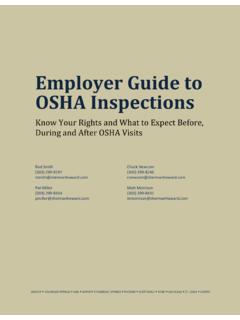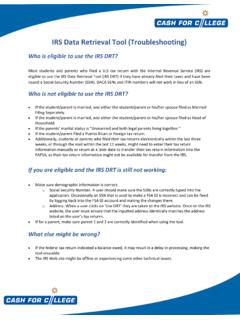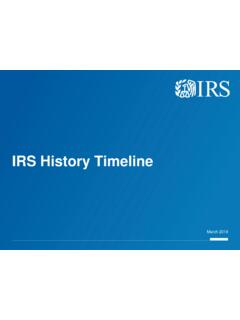Transcription of IRS Procedures for Addressing Missing or Incorrect SSNs1
1 Page 1 of 6 IRS Procedures for Addressing Missing or Incorrect SSNs For more than five years, many agricultural employers have received a disturbing letter from the Social Security Administration (SSA). The letter notifies employers that they reported on their internal revenue Service (IRS) Forms W-2, Wage and Tax Statement, Social Security Numbers (SSNs) and/or employee names that do not match SSA records. According to an SSA publication titled Employer s Guide to Filing Timely and Accurate W-2 Wage Reports, an employer receives this letter if it reported more than 10 no-match SSNs and names that represent more than of the Forms W-2 in the employer s report. (That SSA publication is posted on the SSA s Web site at The so-called Code V mismatch letter asks the employer to respond within 60 days with the information that you are able to correct.)
2 It includes a sheet titled and advising How to Correct SSNs and another enclosure, Tips on Annual Wage Report Filing. It is the second paragraph of that second enclosure that troubles employers. It reads: [The IRS] uses the information we provide to enforce the tax laws, and they could penalize you or your employees for providing Incorrect information. Under the internal revenue Service (sic) Code, the IRS may charge you a $50 penalty for each time you do not furnish an employee s correct SSN on a wage report.. The IRS may impose [this penalty] unless you .. can show reasonable cause for not providing the correct information. (Emphasis added.) Significantly, the letter does not refer to any penalty the SSA itself can impose on an employer for failing to follow the SSA s suggested steps for correcting SSNs, as there is no such penalty.
3 In addition to being fined by the IRS, employers fear that their receipt of multiple SSA mismatch letters for an employee could indicate the employee might not be eligible to be employed in the United States, thus requiring the employer to determine the person s work eligibility to avoid sanctions from Immigration and Customs Enforcement (ICE). The mismatch letter itself notes this letter makes no statement about your employee s immigration status. Further, ICE s predecessor, the Immigration and Naturalization Service (INS), stated in a 1998 letter to Congressman Robert F. Smith: Because there may be many reasons for a mismatch between employer records and SSA records that have nothing to do with work authorization, SSA notice of a mismatch does not trigger by itself an obligation to reverify work authorization.
4 (Emphasis added.) Nonetheless, the INS letter continues: However, the steps an employer should take to reconcile the mismatch with respect to SSA and IRS reporting, such as examining the employee s Social Security card and confirming his or her identity and SSN, may provide the employer with Page 2 of 6 knowledge that is relevant to the employer s [Immigration and Nationality Act] compliance. In particular, if the employee has been given the opportunity to explain and reconcile a discrepancy between the employer s records and SSA s records and has failed to do so satisfactorily, or if the employer learns that the employee is not authorized to work, the employer may be considered by the INS to have violated the prohibition against knowingly continuing to employ an unauthorized alien if it does not take reasonable steps, such as reverification, to ensure that the employee is authorized to work.
5 In those cases, the normal standards that have developed in INS regulations and relevant case law as to what constitutes actual or constructive knowledge of unauthorized status would apply. (Emphasis added.) Thus, the more an employer investigates and tries to resolve the issue, the more likely it is the employer might inadvertently get actual or constructive knowledge that an employee is not truly work-eligible. Accordingly, for many employers the crucial question is knowing the minimum steps an employer must take - and when to take them - to satisfy the IRS requirement of showing reasonable cause for not providing on a wage report correct employee SSN and/or name information. To establish that reasonable cause, many employer advisors have recommended that employers follow the steps requested by the SSA in the enclosures to the mismatch letter upon the letter s receipt.
6 For example, the SSA asks an employer whose records match the information on the employee s Social Security card [to] have the employee contact any Social Security office to resolve the issue. Now, however, IRS Publication 1586, Reasonable Cause Regulations and Requirements for Missing and Incorrect Name/TINs, specifies the steps an employer must take to show reasonable cause and the trigger for doing so. Those steps and their timing differ significantly from the advice typically given employers in the past. Here is a summary of those steps. Slightly different requirements apply depending on whether an IRS penalty is being assessed for a Missing versus an Incorrect SSN. An employer must solicit a new employee for the employee s SSN. An employer must solicit a new employee to complete and submit to the employer IRS Form W-4, Employee s Withholding Allowance Certificate.
7 Because Form W-4 calls for the employee to insert his SSN under Item 2, and because the employee must give the employer a completed Form W-4, an employer satisfies its duty to solicit the employee s SSN by asking for and receiving from a new employee completed Form W-4. Page 3 of 6 If an employer receives an IRS penalty notice for failing to include the employee s SSN on Form W-2, the employer may seek a waiver of the penalty based on the employee s failure to provide an SSN. To justify a penalty waiver, the employer must show that in addition to the initial solicitation for the employee s SSN, the employer again solicited the employee for an SSN in the same calendar year (or by Jan.)
8 31 of the next year for an employee who began work in the prior December). If the employer still does not receive the employee s SSN, the employer must by Dec. 31 of the year after the year in which the employee began work ask the employee for it one more time. If an employer receives an IRS penalty notice for failing to include the employee s correct SSN on Form W-2, the employer may seek a waiver of the penalty based on the employee s failure to provide the correct SSN. To justify a penalty waiver, the employer must show it initially solicited the employee s SSN and then used the SSN the employee provided. The employer must re-solicit the employee s SSN only if it receives an IRS penalty notice that it reported an Incorrect SSN for the employee.
9 If in a later year it receives a second IRS penalty notice, the employer must then make a second re-solicitation. An employer that has made two solicitations in addition to the initial solicitation need not make any further solicitation of the employee even if it receives more IRS penalty notices based on the employee s Missing or Incorrect SSN. Following the Procedures stated in Pub. 1586 should reduce the chance of discovering a problem related to the employment eligibility of an employee for whom multiple mismatch letters are received. That s because the Procedures in Pub. 1586 require an employer to ask such an employee for his SSN only twice in addition to the employer s initial request and, very significantly, only after the employer has received an IRS penalty notice.
10 Thus, whether an employer takes any action in response to its receipt of one or more mismatch letters from SSA has no bearing on its success in showing to the IRS reasonable cause for not providing the correct information on Form W-2. Simply stated, what matters is only that the employer can show it made (1) an initial solicitation of a new employee for the employee s SSN and (2) made, as the circumstances may have required, up to two additional annual solicitations of the employee after it received an IRS penalty notice. Accordingly, when it gets an SSN mismatch letter from SSA (as opposed to an IRS penalty notice), an employer may, without hurting its ability to show the IRS reasonable cause, decide to do nothing more than confirm it used on Form W-2 the SSN provided by the employee when he was hired.



